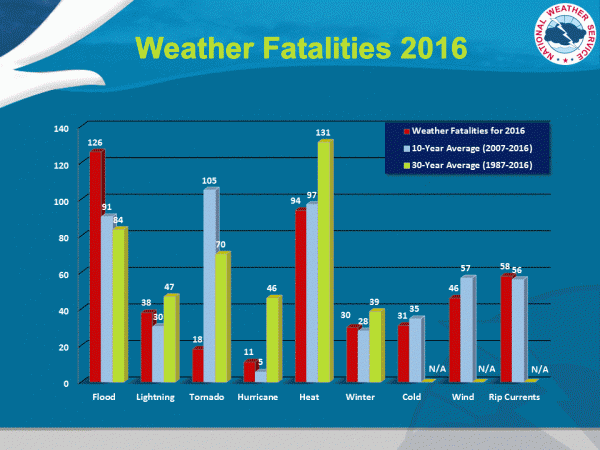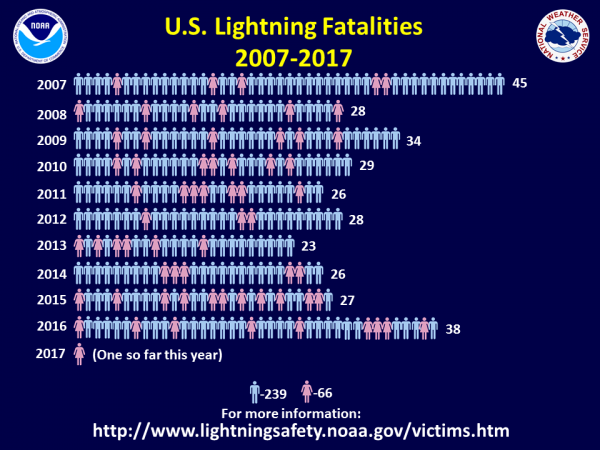NWS Summer Weather Safety Web Site
1. Summary pdf version
2. NWS Excessive Heat Web Site
3. The Science of Lightning pdf version
4. Lightning Safety pdf version
5. Excessive Heat pdf version
6. Who is Vulnerable to Heat? pdf version
7. Heat Index pdf version
8. Heat Advisory/Warning Criteria
9. Common Heat Disorders pdf version
10.Heat Safety pdf versionChildren and Pets left in Vehicles! A Deadly Combination
Visit these other sites on the Internet for additional information
National Weather Service Heat Safety
National Weather Service Lightning Safety
United States Average Deaths

Missouri Heat Related Deaths*
| Year | 2016 | 2015 | 2014 | 2013 | 2012 | 2011 | 2010 | 2009 | 2008 | 2007 | 2006 |
| Deaths | 25 | 17 | 12 | 15 | 52 | 53 | 27 | 14 | 10 | 39 | 27 |
Missouri Heat Related Deaths: 1980 - 2016: 1272
Note: DHSS has recently gone through a review of all past cases of heat related deaths and have made some changes to the numbers. Thus, some of these numbers are different than what was reported last year.
| Year | 2016 | 2015 | 2014 | 2013 | 2012 | 2011 | 2010 | 2009 | 2008 | 2007 | 2006 |
| Deaths | 0 | 2 | 1 | 1 | 0 | 3 | 1 | 2 | 1 | 2 | 0 |
The 3 Deaths in Missouri in 2011 tied with Utah for most in the United States in 2011
The above covers reports received by the National Weather Service in Missouri. Historically, deaths and injuries from lightning have been very under reported.
United States Lightning Deaths: 2016
United States Lightning Deaths: Thus far in 2017
United States Lightning Deaths: 2007 - 2017

According to statistics kept by the National Weather Service, the 30 year average for lightning fatalities across the country is 61. Lightning usually claims only one or two victims at a time, and because lightning does not cause mass destruction, such as from a tornado event or a hurricane, lightning generally receives much less attention than the more destructive storm-related events. Due to under reporting, it is estimated that, more realistically, about 100 - 120 deaths per year occur because of lightning. Documented lightning injuries in the United States average 300 per year; however undocumented lightning injuries are likely much higher.
In Missouri there have been 97 deaths attributed to lightning from 1959 - 2012, an average of 2 deaths per year. In comparison, the the average number of deaths caused by tornadoes since 1950 has risen to 6. So overall, we are doing better in terms of lightning safety.
As the negative particles gather at the bottom of the storm cloud, a pool of positively charged particles gather along the ground and travel with the storm. As the differences in charges increase, positively charged particles rise up taller objects such as trees, houses, and even people. If you are near a storm, and your hair stands on end, the particles are moving up you! The negative charged particles extend down from the cloud in "steps" and form a step leader. When it gets close enough to the ground or a tall object filled with positive particles, a channel is formed and an electrical transfer takes place. There can be several "strokes" which you see as flickering light. The channel heats to about 30,000 degrees Fahrenheit!. The rapid expansion of the heated air around the channel breaks the sound barrier, and you hear thunder.
One lightning stoke can generate between 100 million and 1 billion volts of electricity!
Number and rank of cloud-to-ground flashes by state 2007 - 2016
While many people think they are aware of the dangers of lightning, the vast majority are not. Lightning can strike as much as 10 miles away from the rain area of a thunderstorm; that's about the distance that you are able to hear the thunder from the storm. While virtually all people take some protective actions during the most dangerous part of thunderstorms, many leave themselves vulnerable to being struck by lightning as thunderstorms approach, depart, or are nearby. Although some victims are struck directly by the lightning discharge, many victims are struck as the current moves in and along the ground.
Where are people when lightning incidents occur? The chart below gives a breakdown.
Gender of Victims: 79% Male, 21% Female
Months of Fatal Lightning Incidents
Outdoor Lightning Risk Reduction When a Safe Location is not Nearby
Remember, there is NO safe place outside in a thunderstorm. If you absolutely can't get to safety, this section may help you slightly lessen the threat of being struck by lightning while outside. Â Don't kid yourself--you are NOT safe outside.
Being stranded outdoors when lightning is striking nearby is a harrowing experience. Your first and only truly safe choice is to get to a safe building or vehicle. If you are camping, climbing, on a motorcycle or bicycle, boating, scuba diving, or enjoying other outdoor activities and cannot get to a safe vehicle or building, follow these last resort tips. They will not prevent you from being struck by lightning, but may slightly lessen the odds.
These actions may slightly reduce your risk of being struck by lightning:
* Stay there! The best protection from lightning is a house or other substantial building. However, stay away from windows, doors, and metal pipes.
* Do not use electric appliances during the storm. Turn off sensitive equipment such as televisions, VCR's, and computers.
* Telephone use is the leading cause of indoor lightning injuries in the United States. Do not make a call unless it is an emergency.
Many people do not realize how deadly a heat wave can be. In contrast to the visible, destructive, and violent nature of floods, hurricanes, and tornadoes, a heat wave is a "silent killer". In 1995 alone, 1021 Americans perished in heat waves, including 633 in Illinois and 57 in Missouri.
Most heat-related deaths occur in cities. Brick and mortar buildings, asphalt streets, and tar roofs absorb daytime heat and slowly release it at night. Consequently, temperatures in urban areas can be warmer than rural areas by several degrees both day and night. Some basic comparisons done buy the staff at the NWS St. Louis has found that the temperature in the City of St. Louis often averages about 2 - 5 degrees higher than the temperature at Lambert St. Louis International Airport. higher This is commonly called the urban "heat island" effect. In addition to the burden of heat, stagnant conditions often develop during heat waves, with pollutants increasing in concentration near the ground and contributing further to public health problems during heat waves.

The elderly population segment is the most vulnerable to the dangers of heat. Of the 522 deaths that occurred in Chicago during the July 12-16, 1995 heat wave, 371 (73 percent) were age 65 or older. The elderly suffer due to the diminished ability to perspire. Since the function of perspiration is to provide evaporation, which in turn provides cooling, the elderly have a reduced capacity to release heat from the body.
Measuring the Combined Effects of Heat and Humidity
The National Weather Service uses the Heat Index (HI) to compute the "apparent temperature," which is a measure of how hot it feels to people at a certain combination of temperature and humidity. The heat index values used in forecasts, advisories, and warnings assume an average size adult, with light clothing, in the shade, with a 5 mile per hour wind. Being in full sun, or in an area with little air movement, can increase the apparent temperature, and thus increase the risk for adverse effects from the heat and humidity. Winds greater than 5 miles per hour usually enhance evaporative cooling and decrease the apparent temperature and the health threat from the heat. As noted, the impacts of heat are cumulative over time. The greatest number of heat-induced illnesses and fatalities usually peak two days after the maximum heat index values occurred.
Heat Index
The Heat Index (Apparent Temperature) can be found by taking the temperature (number on the left) and relative humidity value (number at the top) and matching them on this table. For example, a temperature of 90 degrees Fahrenheit and a relative humidity of 45 percent gives you a heat index of 93 degrees.

| Heat Disorder | Symptoms | First Aid |
| Heat Camps | Painful spasms usually in muscles of legs and abdomen due to heavy exertion. Heavy sweating. |
Stop activity and rest in a cool place. Lightly stretch or gently massage muscle to relieve spasms. Give sips of cool water. |
| Heat Exhaustion | Heavy sweating. Skin cool, pale, and clammy. Pulse fast and weak. Breathing fast and shallow. Fainting, dizziness, vomiting, and nausea. |
Get victim to a cool place. Have him/her lie down and loosen clothing. Apply cool, moist cloths. Give sips of cool water. |
| Heat Stroke |
Temperature 103 or higher. No sweating, rapid pulse, fast and shallow breathing. Hot, red, dry skin. Nausea, dizziness, headache, confusion.
|
Heat stroke is a severe medical emergency. Summon emergency assistance or get the victim to a hospital. Delay can be fatal. Move the victim to a cooler environment. Use cool baths or sponging to reduce body temperature. |
* Wear loose-fitting, lightweight, light-colored clothing. If you must go out, use sunscreen and wear a wide-brimmed hat. Remember that sunburn reduces the skin's ability to provide cooling.
* Avoid going out during the hottest times of the day. Take frequent breaks if working during the heat of the day.
* Using a buddy system between co-workers in high heat-stress jobs can help ensure that signs of heat stress do not go unnoticed.
* Inside during the day, keep shades drawn and blinds closed. Use air conditioning whenever available. Even just two hours per day in air conditioning can significantly reduce the risk of heat-related illness.
* Fans should only be used in a ventilated room. Blow hot air out a window with a fan during the day, and blow in cooler air at night.
* Take cool (not icy cold) baths or showers. Eat frequent, small meals. Avoid high protein foods, which increase metabolic heat. Fruits, vegetables, and salads constitute low protein meals.
* Do not leave children or pets in a closed vehicle with the windows up. Temperatures inside a closed vehicle can reach over 140 degrees within minutes.
* Provide extra water and access to a cool environment for pets.
* Listen to NOAA Weather Radio or media sources to keep up with the latest heat watches, warnings, and advisories.